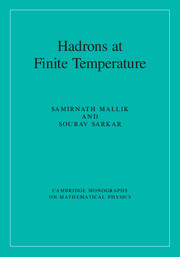Book contents
- Frontmatter
- Dedication
- Contents
- Preface
- Notation
- 1 Free Fields in Vacuum
- 2 Spontaneous Symmetry Breaking
- 3 Chiral Perturbation Theory
- 4 Thermal Propagators
- 5 Thermal Perturbation Theory
- 6 Thermal Parameters
- 7 Two-Loop Results
- 8 Heavy Ion Collisions
- 9 Non-Equilibrium Processes
- Appendix A General Fields
- Appendix B Global Symmetries
- Appendix C Exponential Operator
- Appendix D Propagator at Origin of Coordinates
- Appendix E Reaction Rates in Vacuum and Medium
- Appendix F Coupling Constants
- Appendix G Imaginary Time Method
- Appendix H Quark Condensate from Partition Function
- Appendix I Quark Condensate from Density Expansion
- Index
- References
5 - Thermal Perturbation Theory
Published online by Cambridge University Press: 27 October 2016
- Frontmatter
- Dedication
- Contents
- Preface
- Notation
- 1 Free Fields in Vacuum
- 2 Spontaneous Symmetry Breaking
- 3 Chiral Perturbation Theory
- 4 Thermal Propagators
- 5 Thermal Perturbation Theory
- 6 Thermal Parameters
- 7 Two-Loop Results
- 8 Heavy Ion Collisions
- 9 Non-Equilibrium Processes
- Appendix A General Fields
- Appendix B Global Symmetries
- Appendix C Exponential Operator
- Appendix D Propagator at Origin of Coordinates
- Appendix E Reaction Rates in Vacuum and Medium
- Appendix F Coupling Constants
- Appendix G Imaginary Time Method
- Appendix H Quark Condensate from Partition Function
- Appendix I Quark Condensate from Density Expansion
- Index
- References
Summary
Having derived the thermal propagator matrices for different fields in the last chapter, we now describe how to adapt the conventional (vacuum) perturbative framework to calculate one-point and two-point functions with these matrices. The point here is that although the real line in the time contour (Figure 4.2) gives the physical amplitude, it is not possible to stay with it alone in perturbative calculations; the shifted parallel line also enters through the interaction vertex. Thus, rather than restricting to the original physical amplitude, it is convenient to consider the associated matrix for two-point (and column vector for one-point) functions, involving both segments of the contour. After including perturbative corrections, the result can be diagonalised, giving the corrected amplitiude.
Once the matrix structure is accommodated, the advantages of the real time method relative to the imaginary time one become apparent. The frequency sums in the latter method can be tedious, particularly for graphs with more than one loop. On the other hand, dealing with momentum integrals, the real time method is closer to the vacuum theory as to computation and renormalisation. Further, computations are done in Minkowski space, so no question of analytic continuation to real time is involved.
Matrix Structure
As expected, the perturbative evaluation of thermal amplitudes follows essentially the same steps as for vacuum amplitudes. In particular, the topological structure and combinatorial factors of Feynman graphs remain the same. However, we need to take into account the time contour C, leading to an effective doubling of field variables, as already mentioned in Section 4.2. Thus the thermal perturbation theory replaces the time integral of the interaction Lagrangian (density) of the vacuum theory by [1]
where we leave out the vertical segments of the contour, following earlier discussion. The two types of fields and differ only in their time variables lying on two different segments of C. The minus sign before arises from the reverse direction of the returning time path.
Given a Feynman amplitude in vacuum, it is simple to write the corresponding thermal matrix amplitude.We illustrate below this procedure in detail by writing the amplitudes for some representative graphs in both vacuum and medium.
- Type
- Chapter
- Information
- Hadrons at Finite Temperature , pp. 118 - 136Publisher: Cambridge University PressPrint publication year: 2016



